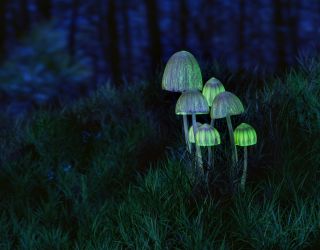Default Mode Network
Improv, Shrooms, and Neuroscience
The cognitive science connection between improv, psilocybin, and meditation.
Posted April 13, 2024 Reviewed by Ray Parker
Key points
- The default mode network (DMN) is the active brain region when people aren't focused on a task.
- Altering DMN connectivity may help people alleviate symptoms of anxiety and depression.
- Research shows that improv, meditation, and psilocybin can decrease activation in the DMN.

Warning: This post may read like a big, old mushroom trip.
I’m about to connect improv, shrooms, meditation, anxiety, depression, and neuroscience.
Over a decade ago, some improv brain scan studies showed improvisers’ brains worked differently during improv than during scripted tasks. I wrote about these studies, led by Charles Limb, in my my first Psychology Today post.
At the time, I focused on two brain regions: the dorsolateral prefrontal cortex (DLPFC) and the medial prefrontal cortex (MPFC). In the simplest terms, the DLPFC is like your inner judge or critic, and the MPFC is linked with language and creativity.
The brain scans showed that freestyle rapping and musical improvisation increased activity in the MPFC and decreased the action of the DLPFC. I love this as a cognitive science metaphor: Improv boosts your creativity by quieting your inner critic. It’s simple, but it makes a lot of sense.
But that's not the whole story.
Improv also reduces activity in something called the default mode network (DMN).
What’s the Default Mode Network?
The default mode network (DMN) is the collection of brain regions that activate when you’re ostensibly doing nothing. When you’re zoning out or on autopilot, your DMN is still working. This can be a good thing: Time can seem to fly by, and creativity can flourish. In fact, this can become a vital part of your creative process because the softened focus of the DMN can help you solve problems unconsciously—effortlessly.
However, many people’s default mode networks lead them to rumination or worry.
Studies have shown that the connectivity of our DMN can lead to some significant mental health concerns, including anxiety, depression, schizophrenia, obsessive-compulsive disorder (OCD), and attention deficit hyperactivity disorder (ADHD).
Quieting the Default Mode Network
The good news is that our default mode network’s settings appear malleable. Limb, one of the researchers behind those aforementioned improv brain scan studies, explains that, in addition to the dorsolateral prefrontal cortex, improv also tends to help “quiet–or ‘deactivate’” the default mode network. Of the DMN, he writes that it:
Comprises a group of brain areas that are generally active when you are daydreaming or resting. It is your brain’s so-called 'default' system. While you are daydreaming, you are generally thinking about yourself: reliving past events, imagining future ones, thinking about how you feel or have felt.
That’s a lot of ego in there, which is why reducing DMN activity seems to boost creativity. Limb explains:
Research shows that the brain is shutting down your inhibitions during these creative moments. It appears that to be really creative, you need to avoid critiquing and controlling your actions, and instead, let yourself go in order to get into the moment, regardless of any mistakes.
So many of our metaphors for creativity are about the dissolution of ego.
- “Get out of your head.”
- “Get out of your own way.”
- “Let go.”
The reduction in activity in the DMN (and DLPFC) may be responsible for that freer thinking and being.
But improv isn't the only activity that can inhibit the default mode network.
Meditation
In many ways, meditation feels like improv’s polar opposite. There’s no silliness or social exchange, but meditation has also been shown to reduce activation in the DMN.
Shrooms
Interestingly, psilocybin (the active ingredient in shrooms) also disrupts DMN connectivity. As Rebecca Smausz, Joanna Neill, and John Gigg explain, "Functional magnetic resonance imaging (fMRI) studies in humans found that psilocybin decreased activity within the PFC, PCC, and other regions across the DMN, profoundly altering consciousness and self-perception."
Now, I’m not suggesting you take shrooms and then meditate or improvise. What I am suggesting is that the links between DMN, increased mental health disorders, and treatments to alter or disrupt DMN connectivity feel important. More studies need to be done to better understand the DMN, its role in our mental health, and tools to disrupt or reset it.
The Takeaway
In the meantime, just know that your DMN is active even when you think your brain has gone offline, and know that sometimes it takes you to Creative Town, and other times it takes you to Worry Island. That doesn’t have to be the end of your story, and that doesn’t have to define you. You are not the DMN. Your default mode can be changed. Maybe gradually. Maybe over an extended period. Maybe on some kind of shroom-induced vision quest. Or maybe by meditating or improvising. Maybe it is the keyword, and for many of the one in five of us struggling with mental health disorders, maybe it feels totally worth pursuing.
References
Carhart-Harris, R. L., Erritzoe, D., Williams, T., Stone, J. M., Reed, L. J., Colasanti, A., ... & Nutt, D. J. (2012). Neural correlates of the psychedelic state as determined by fMRI studies with psilocybin. Proceedings of the National Academy of Sciences, 109(6), 2138-2143.
Garrison, K. A., Zeffiro, T. A., Scheinost, D., Constable, R. T., & Brewer, J. A. (2015). Meditation leads to reduced default mode network activity beyond an active task. Cognitive, Affective, & Behavioral Neuroscience, 15, 712-720.
Gattuso, J. J., Perkins, D., Ruffell, S., Lawrence, A. J., Hoyer, D., Jacobson, L. H., ... & Sarris, J. (2023). Default mode network modulation by psychedelics: a systematic review. International Journal of Neuropsychopharmacology, 26(3), 155-188.
Limb, C. J., & Braun, A. R. (2008). Neural substrates of spontaneous musical performance: An fMRI study of jazz improvisation. PLoS one, 3(2), e1679.
McPherson, M., & Limb, C. (2016, February 20). Making it up as you go along: How your brain improvises. The Guardian. https://www.theguardian.com/education/2016/feb/20/how-brain-freestyles-…
Mental health facts - nami. NAMI. https://www.nami.org/nami/media/nami-media/infographics/generalmhfacts…
Popova, M. (2022, July 7). Improvisation and the Quantum of Consciousness. The Marginalian. https://www.themarginalian.org/2022/07/06/improvisation/
Smausz, R., Neill, J., & Gigg, J. (2022). Neural mechanisms underlying psilocybin’s therapeutic potential–the need for preclinical in vivo electrophysiology. Journal of Psychopharmacology, 36(7), 781-793.




